Yoga in the West : Dilution and Misunderstanding

“There have been some misunderstandings as to what yoga is in the West today. The problem with these misunderstandings is they dilute yogic teachings to the point where yoga is barely recognizable at all”
Susanna Barkataki in the Introduction to Embrace Yoga’s Roots
Well, I will say that the first week of our Summer Book Club does not disappoint, and straight up asks many of the questions I have asked myself and colleagues for years. Being a practitioner within a traditional yoga path that continues to use Sanskrit terms (see page 16 in Embrace Yoga’s Roots) and honors our teacher lineage along with the roots of yoga philosophy, it has been difficult to watch yoga become the popularized workout, anti-guru, English language dominated practice it is today, literally whitewashed of so many of its traditional links. Not that Iyengar Yoga hasn’t fallen into the mentioned “social norms and constructs” that we hope to examine while working through this book. Indeed, BKS Iyengar experienced the need to fit yoga in to our systemic “normative culture” when he was bringing yoga to the West back in the 1950s.
Both Sonali Fiske, the writer of the Foreword, and the author, Susanna Barkataki, bring their experiences of being of South Asian descent, but feeling as a “guest” in Western Yoga spaces. And, BKS Iyengar seemed to feel the need to strip yoga of its spirituality when he first came to teach in the West and faced racism, misunderstanding and fear. As a body-centered, physical fitness aimed culture, we took yoga in the form we wanted it and made it our own. I have met certified teachers of yoga who did not even know that yoga was born in India or Indian culture.
“When we mistake yoga for a workout routine, reduce it to physical fitness or even practice some of the deeper practices without an eye to the whole system of liberation it offers, we rob ourselves and each other of the potential of this practice.”
Introduction pg 5 – Embrace Yoga’s Roots
So what is yoga if not a physical exercise that somehow also benefits our mental stress levels? The Yoga Sutras of Patanjali, the philosophical treatise on yoga, explains in the first Chapter, second sutra : yogas citta vrtti nirodhah – “Yoga is the calming of the fluctuations of the mind in order to find unity within.” (pg 3 – Embrace Yoga’s Roots.) The basis of yoga is that as a human in a body, we have become separated from our True Self. Yoga’s 8-limbed path gives us a practical, step-by-step method toward understanding our own Self, and also the space we hold within the world around us. To view yoga in any other light deprives us of so much of the depth that this ancient practice provides.
I am excited to embark on this study of my own approach to yoga and how I share and engage with others around the subject. I absolutely acknowledge that “even the best-intentioned can cause harm” (pg 6 – Embrace Yoga’s Roots), so I open myself to possibly finding ways in which I have appropriated instead of honored, or through my teaching, created a space where anyone does not feel welcome or included. We must also ask ourselves the hard questions around how we as Western Yoga practitioners have contributed to wrapping yoga into a comfortable package for ourselves, leaving behind any aspect, culture, history or people who had everything to do with its roots.
Join in reading this week – Chapter II – “Tools and Best Practices”